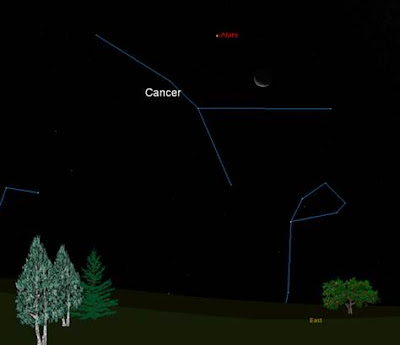
On Friday, Sept. 23, the sun will cross the celestial equator, heading south, in the annual equinox marking the start of the fall season in the Northern Hemisphere and the spring in the south. But this year's equinox brings a special treat: the moon and planet Mars shining together at dawn.
The north's autumnal equinox will occur Friday at 5:05 a.m. EDT (0905 GMT). If you look high toward the east-southeast at sunrise, you’ll see a lovely crescent moon, and hovering above and to its left will be a modestly bright "star" with a yellow-orange tinge. That's no star, but rather the famous Red Planet, Mars.
The sky map of Mars and the moon here shows how they will appear on the Friday's equinox.
These days, Mars is coming up about five hours before sunrise — around 1:50 a.m. local daylight time. It currently resides in the dim constellation of Cancer, the Crab. It's currently 173 million miles from Earth and shines as brightly as a first-magnitude star. (Remember, astronomers measure the brightness of objects as "magnitude." The lower an object's magnitude, the brighter it appears
Read More
The north's autumnal equinox will occur Friday at 5:05 a.m. EDT (0905 GMT). If you look high toward the east-southeast at sunrise, you’ll see a lovely crescent moon, and hovering above and to its left will be a modestly bright "star" with a yellow-orange tinge. That's no star, but rather the famous Red Planet, Mars.
The sky map of Mars and the moon here shows how they will appear on the Friday's equinox.
These days, Mars is coming up about five hours before sunrise — around 1:50 a.m. local daylight time. It currently resides in the dim constellation of Cancer, the Crab. It's currently 173 million miles from Earth and shines as brightly as a first-magnitude star. (Remember, astronomers measure the brightness of objects as "magnitude." The lower an object's magnitude, the brighter it appears
Read More
No comments:
Post a Comment